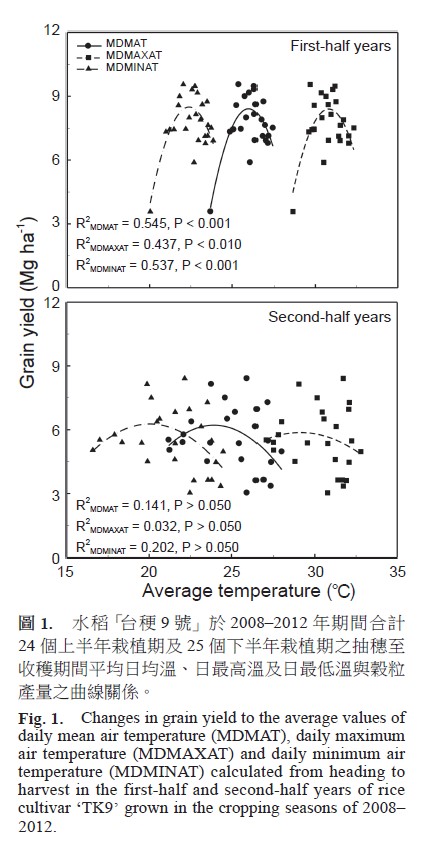All issues

Author:Chia-Hsun Ho, Chwen-Ming Yang*, Chiao-Ling Hsiao, and Ming-Hsin Lai
Abstract:
A five-year field study was conducted in the experimental farm of Taiwan Agricultural Research Institute (TARI) (Wufeng District, Taichung City) in 2008–2012. Rice (Oryza sativa L. cv. ‘TK9’) plants were planted in ‘Lichun’ (means ‘start of spring’) in the first half and ‘Dashu’ (means ‘major hear’) in the second half of the year as well as one and two solar terms before and after them in each year. There were 49 planting times/seasons in total within five-year experimental period, where weather data were also collected from the nearby weather station located at TARI. Five climatic factors, namely, daily mean air temperature (DMAT), daily maximum air temperature (DMAXAT), daily minimum air temperature (DMINAT), daily sunshine hours (DSH), and daily irradiance (DIR) were computed to calculate the respective cumulative (i.e., ADMAT, ADMAXAT, ADMINAT, ADSH, and ADIR) and average (i.e., MDMAT, MDMAXAT, MDMINAT, MDSH, and MDIR) values of these variables during grain-filling stage (from anthesis to harvest). The effects of climatic factors on yield and quality of this cultivar were analyzed based on these datasets. From the results of correlation matrices, crude protein and whiteness of milled rice were positively correlated, while amylose and transparency were negatively correlated, with ADMAT, ADMAXAT and ADMINAT in the first half year. By the stepwise selection of multiple regression analysis, results indicated that the cumulative values of temperatures were the main climatic variables affecting rice quality, but their weights varied with changes in climatic environment in both the first and the second halves of the year. Results showed that rice yield was closely correlated with MDMAT, MDMAXAT, and MDMINAT in a convex curvilinear function. In the first half, the maximum values of yield for MDMINAT, MDMAT and MDMAXAT were occurred near 22.5, 26, and 31℃, respectively, but were shifted to 20, 24, and 29℃ in the second half. Rice quality was also significantly correlated with these three variables in a curvilinear fashion. Crude protein and whiteness of milled rice were positively correlated while amylose and transparency were negatively correlated. Variation was in a greater extent in the first half of the year. As a summary, temperature variables are more important in determining grain yield and rice quality of cultivar ‘TK9’. When combining the experimental results with historical weather data of the major production areas (Maoli County, Taichung City, Changhua County, and Yunlin County) of this cultivar, the best month for grain filling is May in the first half and is October in the second half. To better match these two months for these areas, the first crop should be planted at 15 days before ‘Lichun’ while the second crop should be cultivated at 15 days after ‘Dashu’.
Key words:Solar term, Lichun (start of spring), Dashu (major heat), Daily mean air temperature, Daily maximum air temperature, Daily minimum air temperature
Download:![]() PDF Links
PDF Links
- 1. Development of Tractor-Mounted Seedling Transplanter for Sweet Potato
- 2. Synergistic Effect of Additional Gas on the Toxicity of Phosphine to Sitophilus oryzae and Sitophilus zeamais (Coleoptera: Dryophthoridae)
- 3. Effects of Temperature and Solar Radiation on Growth Traits and Plant Elements in Purple Leafy Sweet Potato
 Submit your manuscript
Submit your manuscript
 Guide for authors
Guide for authors